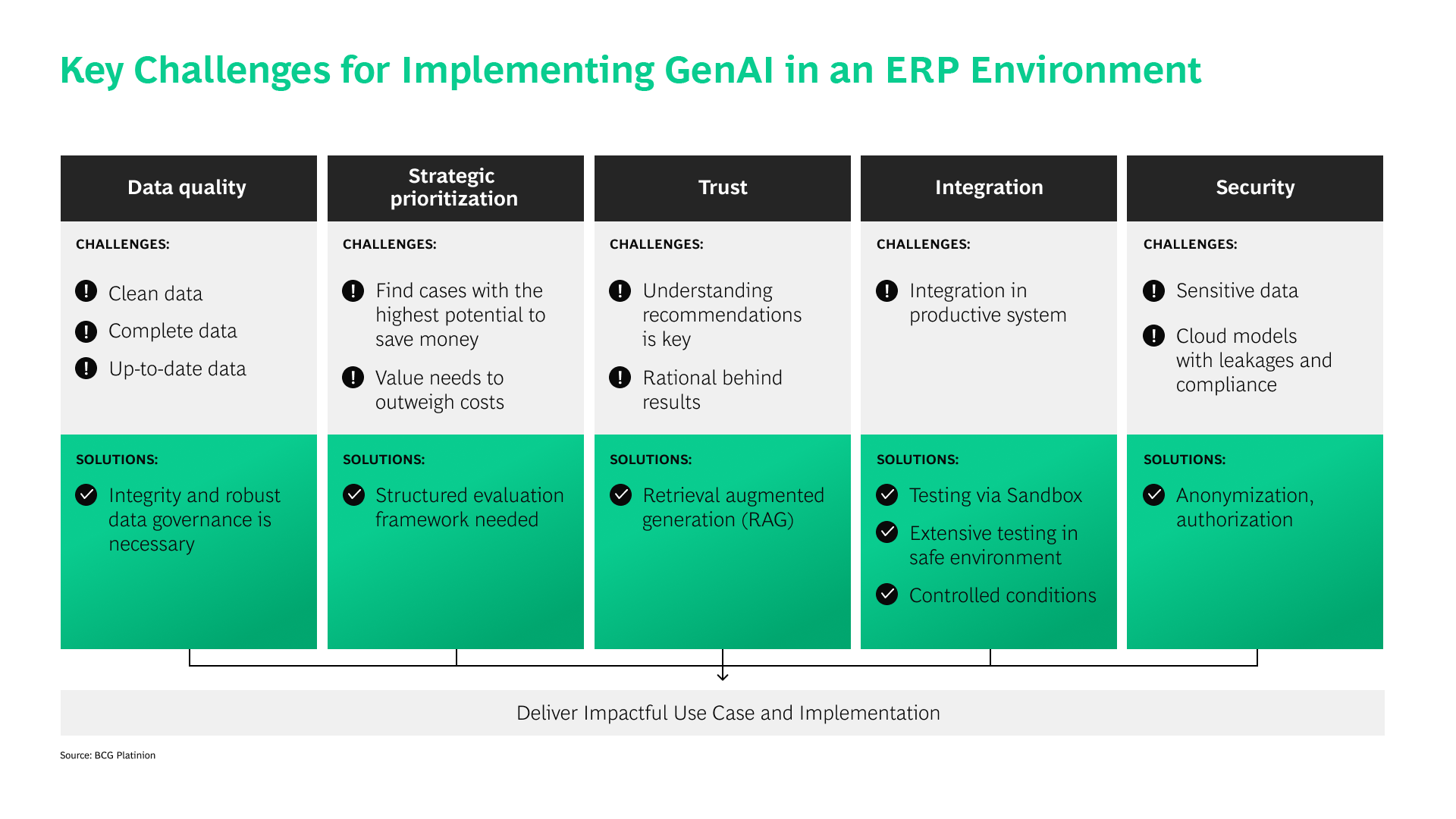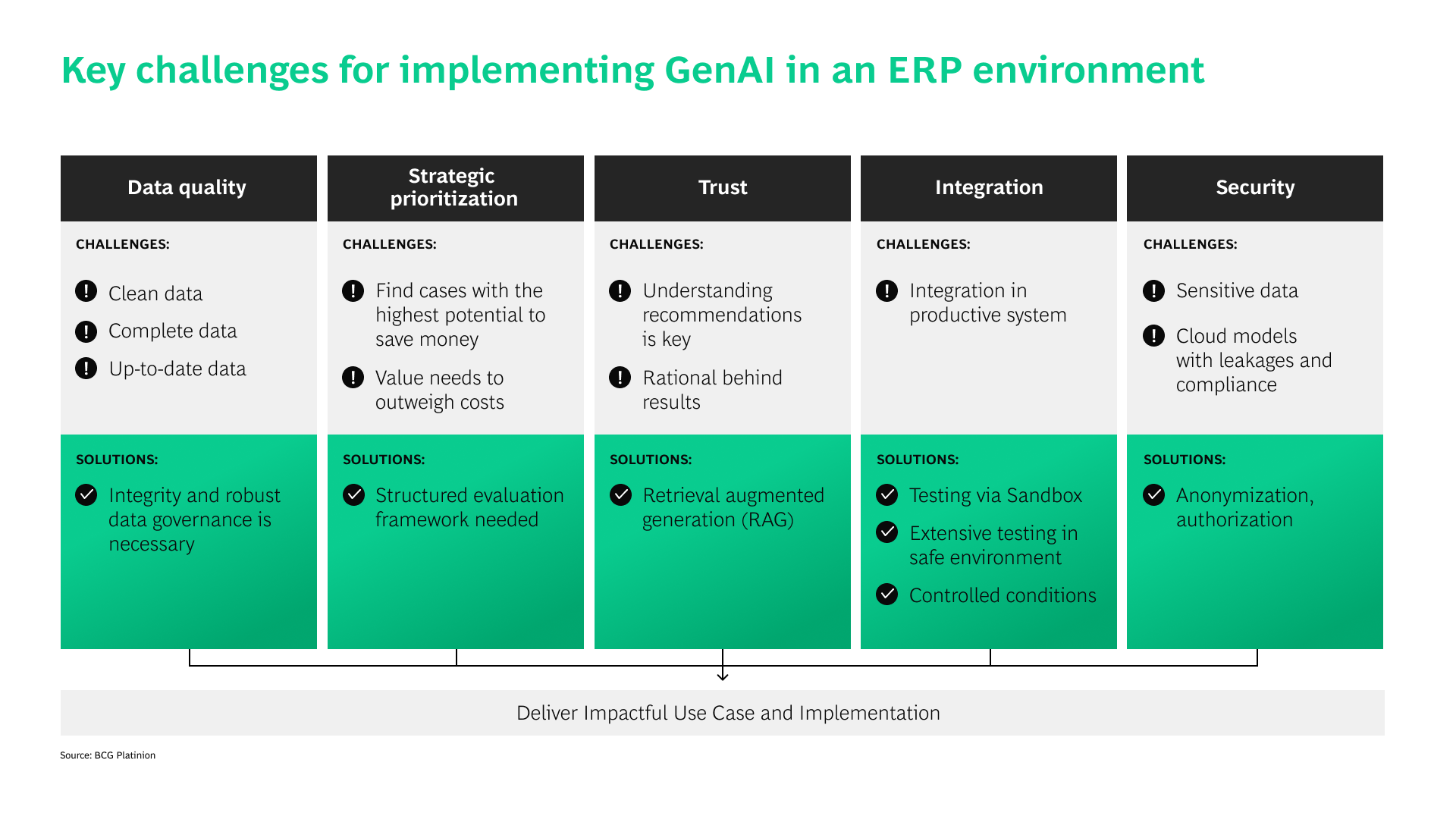GenAI Meets ERP: Achieving Adaptive Enterprise Intelligence
.jpg)
Tomorrow’s industry leaders must seamlessly translate data into action; this calls for a dynamic system of record with a learning and decisioning layer that can execute beyond automation.



Beyond Automation
The fusion of ERP and generative AI (GenAI) is underway, with forward-thinking enterprises looking to achieve a form of adaptive intelligence that surpasses the capabilities of routine automation.
According to a recent report, enterprises are reshaping their ERP roadmaps: 44% plan to invest in AI-powered ERP applications, and 22% say they will replace their current applications if the next release lacks GenAI. These findings underscore the fact that GenAI-driven automation and decision support are becoming table stakes for operational efficiency.
Simply automating manual tasks and standardizing processes may improve operational efficiency, but flexibility is often sacrificed – static business rules limit adaptability in the face of constant change. Continuous change requests and evolving business requirements often lead to high costs and slow time-to-market, with ERP systems sometimes outdated by the time they are delivered.
In contrast, ERP systems strategically equipped with advanced AI technologies like GenAI, agentic AI, and other forms of adaptive intelligence, can continuously monitor for patterns relating to customer demand, detect anomalies, and supply chain bottlenecks.
Predictive AI can forecast sales or detect fraud in financial transactions, while GenAI can be used to automatically generate management-ready reports or simulate “what-if” business scenarios in natural language. Taking it a step further, agentic AI acts autonomously, orchestrating workflows or triggering procurement actions when supplier risks are detected.
For organizations that successfully integrate these capabilities within their ERP systems, it will be like having a living, learning organism woven into the fabric of the business – one capable of passively discovering new growth opportunities hidden in data.
The journey to adaptive intelligence is more than just another advantageous technology upgrade; it is a defining strategic shift that will allow companies to leapfrog competitors.
Supercharge Your Business Functions
Market momentum is unmistakable: AI-enabled applications are expected to be the fastest-growing AI segment, set to grow at a compound annual rate of 56.5% through 2029 and account for 29.9% of AI spend. We will increasingly see AI assistants, advisors, and agents embedded across portfolios, including ERP.
By selecting the right methods and addressing key challenges, the impact of GenAI-enabled ERP is not limited to specific domains. The transformative benefits will be felt enterprise-wide, from the back office to the frontlines.
Finance teams are using GenAI to bring intelligence to reconciliation and invoice processing, generating real-time commentary on financial results. AI assistants can instantly explain variance detected in live ERP data, as opposed to the days of manual analysis typically required. They can also draft quarterly performance summaries for the CFO in real-time.
Procurement is being enhanced by AI models that can rapidly analyse thousands of purchase orders stored in ERP systems. This reveals significant cost saving opportunities and compliance issues simultaneously.
A procurement manager could ask a natural-language query like “which suppliers had the most delayed deliveries last quarter?”, the GenAI system would then comb the ERP supply chain data and provide insights.
Operations functions are gaining greater foresight and autonomy from GenAI embedded in ERP systems, especially in verticals like manufacturing. Production schedules, quality logs, and equipment data can be fed from the ERP system into AI models that optimize shop floors in real-time, enabling AI agents to tweak production plans dynamically.

Supply chain planners are realizing the advantages of GenAI when it comes to navigating complexity. AI systems can generate ‘what if’ scenarios and contingency plans by simulating disruptions, built using ERP logistics data. A planner could ask the system how a port closure in Asia might affect their fall inventory, and receive detailed scenario analysis complete with suggested actions.
IT and ERP support teams are also reaping the benefits. AI coding assistants can help developers write or debug ERP developments (for instance, suggesting fixes to an SAP ABAP code snippet). Helpdesk teams use GenAI to triage and resolve support tickets, and documentation like user manuals no longer need to be created from scratch.
Obstacles to Overcome
There are also obstacles and limiting factors companies need to overcome if they are to succeed.
Data readiness is a primary blocker to scaling AI: a global study shows only 4 of 33 AI POCs typically make it into production (~12%), and ties the low conversion to “low organizational readiness in terms of data, processes and IT infrastructure.” It also lists “availability of quality data” as a top success factor and notes many adopters struggle with insufficient AI-ready data.
GenAI embedded within an ERP system can only become as good as the information it learns from, underlining the importance of clean, complete, up-to-date data sets. But ERP systems can present a major opportunity when it comes to data – they are the central data backbone of most companies, providing access to rich transactional data generated by business processes across finance, supply chain, and operations.
Taking a scattergun approach to GenAI pilot projects risks implementation costs outweighing the benefits, undermining both credibility and momentum as a result. The solution is to prioritize the right GenAI use cases, with the support of a structured evaluation framework (ensuring investments remain aligned with measurable outcomes).
Limited explainability and trust can also derail GenAI implementations within ERP systems. This is because some models, especially large neural networks, can behave like black boxes and lack transparency, making it hard to explain certain answers or recommendations.
Especially in sensitive domains like finance and supply chain, business owners and auditors need AI-driven decisions to be backed by clear rationale. Examples include vector database searches of logs to retrieve supporting data from the ERP, and reason codes for each output.

Integration of GenAI projects in legacy systems is also a non-trivial obstacle, with many enterprises running older ERP versions or heavily customized modules. Sandbox environments for experimentation can be a highly effective solution, providing a playground in which AI models can be tested on a copy of the existing ERP data. This method does more than just protect live operations; it offers a controlled environment in which to accelerate the training of AI models.
Security and privacy concerns loom large as well, with financial information and HR records at increased risk when experimenting with AI. The involvement of external cloud models only adds to these heightened risk levels, making precautions like anonymization and strict access controls even more essential.
The state of play. Today, we see predictive AI embedded in many analytical tools within ERP systems, and adopted by companies as a result. Applications of GenAI are also increasingly common, but they are rarely fully integrated within transactional processes – often they remain locked within the bounds of GPT. It is still early in the game for agentic AI in the ERP context, with more time required for current examples to reach full maturity.
Case Study: Adaptive Intelligence in Action
A BCG Platinion project involving a global automotive manufacturer stands out as a prime example of adaptive intelligence in action. The goal of this engagement was to help the client revamp its procurement operations using a GenAI-powered offer-analyst solution, deployed in a secure cloud environment.
The client’s traditional offers-processing workflow presented a number of pain points. While meticulous, the existing system was weighed down by laborious proofreading and document comparison processes that required coordination with multiple stakeholders. Human operators were overburdened, and outcome quality was suffering as a result.
The BCG Platinion team leveraged GenAI to design a solution called Offer Analyst, which streamlined and enhanced the offer evaluation process. Featuring an interface that simplifies complex analysis, the custom-built tool automated the document review and comparison stages, as well as previously arduous compliance checks.
Case Study: Zero-touch GenAI Invoice Processing
In a project involving a major German energy provider, the BCG Platinion team helped orchestrate the training of a GenAI model using 10,000 invoices. This initial process equipped the model to handle hundreds of thousands of line items – the results were then compiled in a large Excel model, and a manual review on a sample basis was conducted.
OCR is used to read and digitize the invoice content, identifying key data like invoice numbers and vendor names. Data validation and matching is then also carried out autonomously, before coding and approval routing. Payment and exception handling is the final stage in an ongoing cycle of continuous learning and optimization.
After four months of this process, fully autonomous processing capabilities were launched for key invoice categories and financial thresholds. As a result, the client experienced a 400% efficiency increase per targeted employee, and the organization is on track to achieve 75% touchless invoice processing as soon as 2027.
Another industry-leading enterprise called on BCG Platinion because it had an extremely long tail of suppliers to manage (and the existing invoice processing system had become highly complex). The Platinion team devised a sophisticated approach that involved integrating AI-powered OCR, VAT check automation, and automated accounts payable capabilities - a step-by-step logic was then used to balance risk and automation while ensuring smooth implementation.
Adopting Systems of Intelligence: Three Models
Across all of the possible GenAI applications we have explored, a consistent theme emerges: GenAI is turning ERP from systems of record into systems of intelligence.
Without uprooting existing foundations, intuitive AI assistants are empowering employees and adapting established processes. The result for enterprises that successfully adopt GenAI will be true adaptive intelligence - the ability to nimbly navigate the challenges of unprecedented real-world change.
As organizations increasingly recognize the advantages, clients ask us: “Should we build our own solution or wait for an ERP vendor?” The answer is usually both – quick wins now, vendor scale later:
- Native ERP – Use the AI capabilities embedded in platforms provided by vendors. This route is best for end-to-end process “AI-ification” but will be limited to vendor rollout timelines
- Third party AI – Add specialized tools provided by third-party vendors on top of ERP, this approach is not tethered to vendor roadmaps and great for fast, targeted use cases
- Custom build – Develop bespoke GenAI or agentic AI solutions with maximum flexibility, but requires internal capability and governance
To discover more about GenAI for ERP systems, or how to go about turning your system of records into systems of intelligence, simply get in touch with our expert team below!



